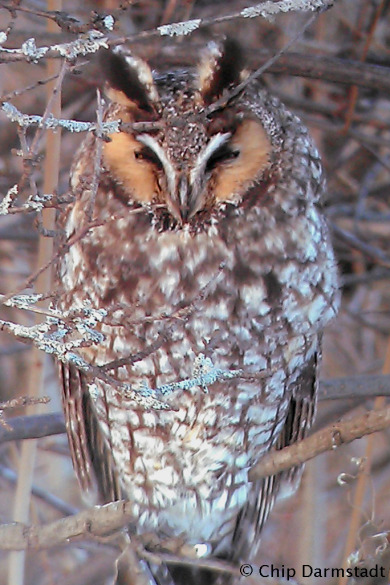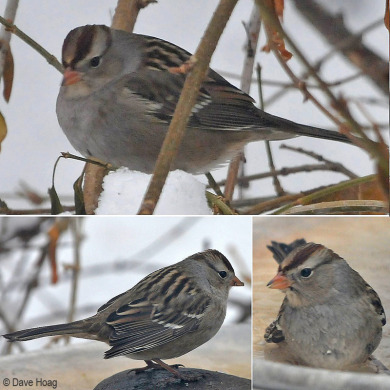
Long-eared Owl from the Plainfield Christmas Bird Count.
As we all know, Christmas Bird Counts aren’t only about finding rare birds. A Black-capped Chickadee would count the same as a Black-capped Petrel. (Well, okay, almost.) But all those birders out during the count period are bound to discover new and unusual birds. So here’s a summary, in no particular order, of what was hot during the 115th Vermont Christmas Bird Count season. Our apologies for not getting results from all the counts just yet.
On the Plainfield count, Chip Darmstadt discovered a Long-eared Owl — a first for the count and rare in Vermont outside the Champlain Valley (even inside it as well). Another first for the Plainfield count was a lone Snow Goose seen flying south. “Southern” species continue an upward trend on the Plainfield count, with the second-ever sighting of Red-bellied Woodpecker. Carolina Wren was observed for only the fourth time, with a record high of three individuals observed (all at feeders). Northern Cardinal and Tufted Titmouse, which have seen large increases in the past decade, were seen in decent numbers, with 41 and 17 respectively. Meanwhile, during the count period on January 1, a contingency of the Mad Birders, visiting Montpelier, discovered an Orange-crowned Warbler on Harrison Avenue, first noticed by Zacheriah Cota-Weaver.
Nearby, Pat Folsom, a founding member of the Mad Birders, reports that a Hermit Thrush and Horned Lark were new to the Mad River Valley/Northfield count, which completed it tenth season. Also noteworthy were Ring-necked Duck, Hooded Merganser, Belted Kingfisher (guess they had some open water, like lots of other counts), Eastern Bluebird, Brown-headed Cowbirds and Chipping Sparrow. The Mad River/Northfield count was also featured on WCAX -TV. Watch it here.
Heading west, to the Hinesburg count, Ali Wagner reports a Northern Shrike. Ali also encountered a shrike during the Burlington count “This one was pursuing a Blue Jay which was quite funny to watch,” she says. “The Jay would just flutter a bit and perch in a different spot of the tree, just enough to keep the shrike trying.”
In its 40th year, the Woodstock count included two new species: Eastern Phoebe and Hermit Thrush. A Great Blue Heron found some open water. Woodstock also had a Bald Eagle in the count period. Accolades go to Sally Laughlin for continuing to lead this storied Vermont count.
Reporting from the Hanover-Norwich count, Doug and Spencer Hardy note that highlights included a Merlin, two Hermit Thrushes, and five Eastern Bluebirds. Doug also points out that with the Connecticut River still open, the count had relatively high waterfowl numbers, including four Wood Ducks, 450 Mallards, and roughly 85 Hooded Mergansers.
Notable from Ferrisburgh, according to Mike Winslow, was a report of a Red-headed Woodpecker. Attempts to relocate the bird the next day were unsuccessful. Meanwhile, another high-producing count, Burlington, set a record with 77 species and the most birds ever counted at 21,306, due in large part to an enormous American Crow roost (roughly 3,000 birds) and counts of 6,815 Greater Scaup and 751 Lesser Scaup, says Bruce MacPherson. Bruce also says that Al Strong’s owling team came up with four species, including five Eastern Screech Owls, one Snowy Owl, three Great Horned Owls, and one Barred Owl. New records were set for Common Loons (13), Cooper’s Hawk (9), Red-bellied Woodpecker (17), and Carolina Wren (20), among several others. Other notables included a Fox Sparrow, an Eastern Towhee, a Merlin, and two lingering Hermit Thrushes. (Are we seeing a trend here with Hermit Thrush?) Burlington also counted three Wood Ducks, a Brown Thrasher, and a Savannah Sparrow.

Dave Hoag’s White-crowned Sparrow
Ken Copenhaver, reporting in from the Champlain Islands, notes 73 count-day species, compared with a high count of 76 species in 2005 and 62 species last year. Total individuals amounted to 14,798, compared with a high of 28,305 in 2011 and 18,362 last year. Notables included three Barrow’s Goldeneye, one Snowy Owl, two Swamp Sparrows and six White-throated Sparrows. Meanwhile, a half-mile outside the count circle, Dave Hoag found an immature White-crowned Sparrow of the “Gamble’s race” from the interior West of the continent — a good find indeed.
In Franklin County, Charlotte Bill says, “This was our third-ever CBC in this neck of the woods and the best yet!” No doubt, three White-crowned Sparrows at a feeder saw to that. Also notable were Song Sparrow, White-throated Sparrow, and Common Grackle — one of each. The total came in at a respectable 40 species for the count — a record.
And finally, in Rutland, Roy Pilcher commented on the open water and lack of snow making it feel more like April than December. Individual bird numbers came in at 5,705, compared to a running ten-year average of 8,638. Rutland birders tallied 49 species, compared to a running ten-year average of 51. Two Peregrine Falcons and three Great Blue Herons were notable. Red-bellied Woodpecker came in at a record high of 10. And one Common Yellowthroat made it for the count as well. You can read Roy’s full report here.
That’s it for now. Thanks, everyone. Onward to more fine birding in the New Year.
